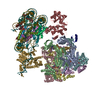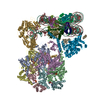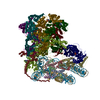[English] 日本語
 Yorodumi
Yorodumi- EMDB-3954: Cryo-EM structure of the human INO80 complex bound to nucleosome -
+ Open data
Open data
- Basic information
Basic information
| Entry | Database: EMDB / ID: EMD-3954 | ||||||||||||
|---|---|---|---|---|---|---|---|---|---|---|---|---|---|
| Title | Cryo-EM structure of the human INO80 complex bound to nucleosome | ||||||||||||
 Map data Map data | map of human INO80 bound to nucleosome | ||||||||||||
 Sample Sample |
| ||||||||||||
| Function / homology |  Function and homology information Function and homology information: / : / chromatin remodeling => GO:0006338 / ATP-dependent chromatin remodeler activity => GO:0140658 / promoter-enhancer loop anchoring activity / positive regulation of nuclear cell cycle DNA replication / regulation of DNA strand elongation / positive regulation of telomere maintenance in response to DNA damage / establishment of protein localization to chromatin / R2TP complex ...: / : / chromatin remodeling => GO:0006338 / ATP-dependent chromatin remodeler activity => GO:0140658 / promoter-enhancer loop anchoring activity / positive regulation of nuclear cell cycle DNA replication / regulation of DNA strand elongation / positive regulation of telomere maintenance in response to DNA damage / establishment of protein localization to chromatin / R2TP complex / Swr1 complex / dynein axonemal particle / RPAP3/R2TP/prefoldin-like complex / regulation of double-strand break repair / positive regulation of telomerase RNA localization to Cajal body / Ino80 complex / UV-damage excision repair / box C/D snoRNP assembly / protein folding chaperone complex /  NuA4 histone acetyltransferase complex / DNA duplex unwinding / regulation of chromosome organization / positive regulation of double-strand break repair via homologous recombination / protein deubiquitination / regulation of G1/S transition of mitotic cell cycle / mitotic sister chromatid segregation / NuA4 histone acetyltransferase complex / DNA duplex unwinding / regulation of chromosome organization / positive regulation of double-strand break repair via homologous recombination / protein deubiquitination / regulation of G1/S transition of mitotic cell cycle / mitotic sister chromatid segregation /  regulation of DNA replication / regulation of DNA replication /  MLL1 complex / TFIID-class transcription factor complex binding / MLL1 complex / TFIID-class transcription factor complex binding /  regulation of embryonic development / alpha-tubulin binding / Telomere Extension By Telomerase / negative regulation of tumor necrosis factor-mediated signaling pathway / spindle assembly / RNA polymerase II core promoter sequence-specific DNA binding / negative regulation of megakaryocyte differentiation / regulation of embryonic development / alpha-tubulin binding / Telomere Extension By Telomerase / negative regulation of tumor necrosis factor-mediated signaling pathway / spindle assembly / RNA polymerase II core promoter sequence-specific DNA binding / negative regulation of megakaryocyte differentiation /  regulation of DNA repair / protein localization to CENP-A containing chromatin / ATP-dependent activity, acting on DNA / Chromatin modifying enzymes / Replacement of protamines by nucleosomes in the male pronucleus / CENP-A containing nucleosome / epigenetic regulation of gene expression / Packaging Of Telomere Ends / Recognition and association of DNA glycosylase with site containing an affected purine / Cleavage of the damaged purine / Deposition of new CENPA-containing nucleosomes at the centromere / Recognition and association of DNA glycosylase with site containing an affected pyrimidine / Cleavage of the damaged pyrimidine / positive regulation of DNA repair / Inhibition of DNA recombination at telomere / Meiotic synapsis / regulation of DNA repair / protein localization to CENP-A containing chromatin / ATP-dependent activity, acting on DNA / Chromatin modifying enzymes / Replacement of protamines by nucleosomes in the male pronucleus / CENP-A containing nucleosome / epigenetic regulation of gene expression / Packaging Of Telomere Ends / Recognition and association of DNA glycosylase with site containing an affected purine / Cleavage of the damaged purine / Deposition of new CENPA-containing nucleosomes at the centromere / Recognition and association of DNA glycosylase with site containing an affected pyrimidine / Cleavage of the damaged pyrimidine / positive regulation of DNA repair / Inhibition of DNA recombination at telomere / Meiotic synapsis /  DNA helicase activity / telomere organization / DNA helicase activity / telomere organization /  telomere maintenance / TBP-class protein binding / RNA Polymerase I Promoter Opening / Interleukin-7 signaling / SUMOylation of chromatin organization proteins / Assembly of the ORC complex at the origin of replication / telomere maintenance / TBP-class protein binding / RNA Polymerase I Promoter Opening / Interleukin-7 signaling / SUMOylation of chromatin organization proteins / Assembly of the ORC complex at the origin of replication /  DNA methylation / Condensation of Prophase Chromosomes / HCMV Late Events / Chromatin modifications during the maternal to zygotic transition (MZT) / ERCC6 (CSB) and EHMT2 (G9a) positively regulate rRNA expression / SIRT1 negatively regulates rRNA expression / DNA methylation / Condensation of Prophase Chromosomes / HCMV Late Events / Chromatin modifications during the maternal to zygotic transition (MZT) / ERCC6 (CSB) and EHMT2 (G9a) positively regulate rRNA expression / SIRT1 negatively regulates rRNA expression /  innate immune response in mucosa / PRC2 methylates histones and DNA / Defective pyroptosis / cellular response to estradiol stimulus / innate immune response in mucosa / PRC2 methylates histones and DNA / Defective pyroptosis / cellular response to estradiol stimulus /  ADP binding / HDACs deacetylate histones / cellular response to ionizing radiation / RNA Polymerase I Promoter Escape / Nonhomologous End-Joining (NHEJ) / ADP binding / HDACs deacetylate histones / cellular response to ionizing radiation / RNA Polymerase I Promoter Escape / Nonhomologous End-Joining (NHEJ) /  lipopolysaccharide binding / Transcriptional regulation by small RNAs / double-strand break repair via homologous recombination / lipopolysaccharide binding / Transcriptional regulation by small RNAs / double-strand break repair via homologous recombination /  Hydrolases; Acting on acid anhydrides; Acting on acid anhydrides to facilitate cellular and subcellular movement / Formation of the beta-catenin:TCF transactivating complex / DNA Damage Recognition in GG-NER / negative regulation of canonical Wnt signaling pathway / Hydrolases; Acting on acid anhydrides; Acting on acid anhydrides to facilitate cellular and subcellular movement / Formation of the beta-catenin:TCF transactivating complex / DNA Damage Recognition in GG-NER / negative regulation of canonical Wnt signaling pathway /  euchromatin / RUNX1 regulates genes involved in megakaryocyte differentiation and platelet function / Activated PKN1 stimulates transcription of AR (androgen receptor) regulated genes KLK2 and KLK3 / G2/M DNA damage checkpoint / NoRC negatively regulates rRNA expression / B-WICH complex positively regulates rRNA expression / HDMs demethylate histones / DNA Damage/Telomere Stress Induced Senescence / spindle / chromatin DNA binding / Metalloprotease DUBs / PKMTs methylate histone lysines / RMTs methylate histone arginines / euchromatin / RUNX1 regulates genes involved in megakaryocyte differentiation and platelet function / Activated PKN1 stimulates transcription of AR (androgen receptor) regulated genes KLK2 and KLK3 / G2/M DNA damage checkpoint / NoRC negatively regulates rRNA expression / B-WICH complex positively regulates rRNA expression / HDMs demethylate histones / DNA Damage/Telomere Stress Induced Senescence / spindle / chromatin DNA binding / Metalloprotease DUBs / PKMTs methylate histone lysines / RMTs methylate histone arginines /  beta-catenin binding / beta-catenin binding /  Meiotic recombination / Pre-NOTCH Transcription and Translation / Meiotic recombination / Pre-NOTCH Transcription and Translation /  nuclear matrix / nuclear matrix /  nucleosome assembly nucleosome assemblySimilarity search - Function | ||||||||||||
| Biological species |   Homo sapiens (human) / synthetic construct (others) Homo sapiens (human) / synthetic construct (others) | ||||||||||||
| Method |  single particle reconstruction / single particle reconstruction /  cryo EM / Resolution: 4.8 Å cryo EM / Resolution: 4.8 Å | ||||||||||||
 Authors Authors | Ayala R / Willhoft O / Aramayo RJ / Wilkinson M / McCormack EA / Ocloo L / Wigley DB / Zhang X | ||||||||||||
| Funding support |  United Kingdom, 3 items United Kingdom, 3 items
| ||||||||||||
 Citation Citation |  Journal: Nature / Year: 2018 Journal: Nature / Year: 2018Title: Structure and regulation of the human INO80-nucleosome complex. Authors: Rafael Ayala / Oliver Willhoft / Ricardo J Aramayo / Martin Wilkinson / Elizabeth A McCormack / Lorraine Ocloo / Dale B Wigley / Xiaodong Zhang /  Abstract: Access to DNA within nucleosomes is required for a variety of processes in cells including transcription, replication and repair. Consequently, cells encode multiple systems that remodel nucleosomes. ...Access to DNA within nucleosomes is required for a variety of processes in cells including transcription, replication and repair. Consequently, cells encode multiple systems that remodel nucleosomes. These complexes can be simple, involving one or a few protein subunits, or more complicated multi-subunit machines . Biochemical studies have placed the motor domains of several chromatin remodellers in the superhelical location 2 region of the nucleosome. Structural studies of yeast Chd1 and Snf2-a subunit in the complex with the capacity to remodel the structure of chromatin (RSC)-in complex with nucleosomes have provided insights into the basic mechanism of nucleosome sliding performed by these complexes. However, how larger, multi-subunit remodelling complexes such as INO80 interact with nucleosomes and how remodellers carry out functions such as nucleosome sliding , histone exchange and nucleosome spacing remain poorly understood. Although some remodellers work as monomers , others work as highly cooperative dimers. Here we present the structure of the human INO80 chromatin remodeller with a bound nucleosome, which reveals that INO80 interacts with nucleosomes in a previously undescribed manner: the motor domains are located on the DNA at the entry point to the nucleosome, rather than at superhelical location 2. The ARP5-IES6 module of INO80 makes additional contacts on the opposite side of the nucleosome. This arrangement enables the histone H3 tails of the nucleosome to have a role in the regulation of the activities of the INO80 motor domain-unlike in other characterized remodellers, for which H4 tails have been shown to regulate the motor domains. | ||||||||||||
| History |
|
- Structure visualization
Structure visualization
| Movie |
 Movie viewer Movie viewer |
|---|---|
| Structure viewer | EM map:  SurfView SurfView Molmil Molmil Jmol/JSmol Jmol/JSmol |
| Supplemental images |
- Downloads & links
Downloads & links
-EMDB archive
| Map data |  emd_3954.map.gz emd_3954.map.gz | 10.5 MB |  EMDB map data format EMDB map data format | |
|---|---|---|---|---|
| Header (meta data) |  emd-3954-v30.xml emd-3954-v30.xml emd-3954.xml emd-3954.xml | 31 KB 31 KB | Display Display |  EMDB header EMDB header |
| FSC (resolution estimation) |  emd_3954_fsc.xml emd_3954_fsc.xml | 9.7 KB | Display |  FSC data file FSC data file |
| Images |  emd_3954.png emd_3954.png | 65.5 KB | ||
| Others |  emd_3954_additional.map.gz emd_3954_additional.map.gz | 63.1 MB | ||
| Archive directory |  http://ftp.pdbj.org/pub/emdb/structures/EMD-3954 http://ftp.pdbj.org/pub/emdb/structures/EMD-3954 ftp://ftp.pdbj.org/pub/emdb/structures/EMD-3954 ftp://ftp.pdbj.org/pub/emdb/structures/EMD-3954 | HTTPS FTP |
-Related structure data
| Related structure data |  6htsMC M: atomic model generated by this map C: citing same article ( |
|---|---|
| Similar structure data |
- Links
Links
| EMDB pages |  EMDB (EBI/PDBe) / EMDB (EBI/PDBe) /  EMDataResource EMDataResource |
|---|---|
| Related items in Molecule of the Month |
- Map
Map
| File |  Download / File: emd_3954.map.gz / Format: CCP4 / Size: 103 MB / Type: IMAGE STORED AS FLOATING POINT NUMBER (4 BYTES) Download / File: emd_3954.map.gz / Format: CCP4 / Size: 103 MB / Type: IMAGE STORED AS FLOATING POINT NUMBER (4 BYTES) | ||||||||||||||||||||||||||||||||||||||||||||||||||||||||||||||||||||
|---|---|---|---|---|---|---|---|---|---|---|---|---|---|---|---|---|---|---|---|---|---|---|---|---|---|---|---|---|---|---|---|---|---|---|---|---|---|---|---|---|---|---|---|---|---|---|---|---|---|---|---|---|---|---|---|---|---|---|---|---|---|---|---|---|---|---|---|---|---|
| Annotation | map of human INO80 bound to nucleosome | ||||||||||||||||||||||||||||||||||||||||||||||||||||||||||||||||||||
| Voxel size | X=Y=Z: 1.09 Å | ||||||||||||||||||||||||||||||||||||||||||||||||||||||||||||||||||||
| Density |
| ||||||||||||||||||||||||||||||||||||||||||||||||||||||||||||||||||||
| Symmetry | Space group: 0 | ||||||||||||||||||||||||||||||||||||||||||||||||||||||||||||||||||||
| Details | EMDB XML:
CCP4 map header:
| ||||||||||||||||||||||||||||||||||||||||||||||||||||||||||||||||||||
-Supplemental data
-Additional map: blurred map (with a factor applied of 250)...
| File | emd_3954_additional.map | ||||||||||||
|---|---|---|---|---|---|---|---|---|---|---|---|---|---|
| Annotation | blurred map (with a factor applied of 250) to help visualise the nucleosome and flexible regions of the complex that have not been modelled | ||||||||||||
| Projections & Slices |
| ||||||||||||
| Density Histograms |
- Sample components
Sample components
+Entire : Complex of core human INO80 with nucleosome
+Supramolecule #1: Complex of core human INO80 with nucleosome
+Supramolecule #2: nucleosome
+Supramolecule #4: human INO80
+Supramolecule #3: Histone subunits
+Macromolecule #1: RuvB-like 1
+Macromolecule #2: RuvB-like 2
+Macromolecule #3: DNA helicase INO80
+Macromolecule #4: Actin-related protein 5
+Macromolecule #5: Histone H3.1
+Macromolecule #6: Histone H4
+Macromolecule #7: Histone H2A type 1-B/E
+Macromolecule #8: Histone H2B type 1-J
+Macromolecule #9: INO80 complex subunit B
+Macromolecule #10: DNA (142-MER)
+Macromolecule #11: DNA (142-MER)
+Macromolecule #12: ADENOSINE-5'-DIPHOSPHATE
+Macromolecule #13: ZINC ION
-Experimental details
-Structure determination
| Method |  cryo EM cryo EM |
|---|---|
 Processing Processing |  single particle reconstruction single particle reconstruction |
| Aggregation state | particle |
- Sample preparation
Sample preparation
| Buffer | pH: 8 |
|---|---|
| Vitrification | Cryogen name: ETHANE / Chamber humidity: 100 % / Chamber temperature: 277 K |
- Electron microscopy
Electron microscopy
| Microscope | FEI TITAN KRIOS |
|---|---|
| Electron beam | Acceleration voltage: 300 kV / Electron source:  FIELD EMISSION GUN FIELD EMISSION GUN |
| Electron optics | Illumination mode: FLOOD BEAM / Imaging mode: BRIGHT FIELD Bright-field microscopy / Cs: 2.7 mm Bright-field microscopy / Cs: 2.7 mm |
| Image recording | Film or detector model: FEI FALCON III (4k x 4k) / Detector mode: INTEGRATING / Average electron dose: 80.0 e/Å2 |
| Experimental equipment |  Model: Titan Krios / Image courtesy: FEI Company |
 Movie
Movie Controller
Controller























 Z
Z Y
Y X
X













